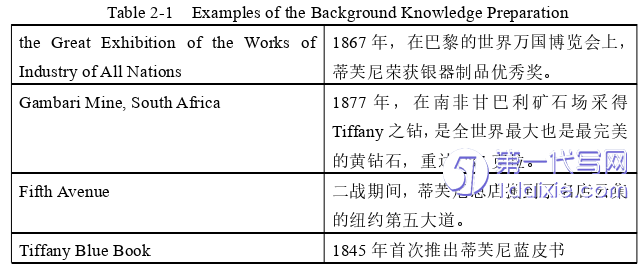本文是一篇英语论文,本文介绍任务背景以及任务特点与难点,并详细呈现整个翻译过程,包括译前准备、翻译过程实施和译后反思;通过案例分析,以李长栓教授的理解、表达、变通框架为指导,释意论为理论依据,分析并解决口译任务过程中存在的困难和问题。
Chapter One Task Description
1.1 Background of the Task
The lecture is named“Inside the Turquoise Box:Tiffany Silver at the New YorkHistorical Society”.It was given by Doctor Debra Schmidt Bach with the New YorkHistorical Society Museum&Library on December 2,2020.The recorded video ofthis lecture is published on its YouTube account.
The lecture is a part of the organization’s Curator Confidential Program.It’sgiven to Americans to reveal Tiffany&Co.’s story through a virtual look at themuseum’s incomparable collections of Tiffany&Co.silver treasures,because manyAmericans associate the name Tiffany&Co.with the company’s iconic turquoiseboxes,but few are aware of the fascinating 183-year history of this New Yorkretailer.
Held on Zoom,the lecture has native listeners who submit questions to DoctorBach at the end of the lecture,and the Q&A session takes about 5 minutes.
1.2 Features and Difficulties of the Task
During the task,the interpreter encountered several difficulties that may hindereither the understanding and hence the interpreting of the lecture.These difficultiesin the interpreting task are listed as follows.
Firstly,the sole speaker of the lecture is Doctor Debra Schmidt Bach,whospeaks at a relatively fast pace,which makes it difficult for the interpreter to catch upwith her.
Secondly,in the lecture,the speaker referred to many English names andaddresses,which are difficult for the interpreter to pronounce in Chinese charactersin a short time because pronouncing more words would take more time,thusdistracting a novice simultaneous interpreter from capturing other information.
Thirdly,the lecture referred to many figures,such as years,which are hard tocapture precisely.
Fourthly,in the lecture,there is a lot of terminology regarding the luxury industry,silver,silver manufacturing,etc.All those words should be prepared beforethe task.
Chapter Two Interpreting Process
2.1 Preparations for the Task
Adequate preparation can help interpreters understand the nature and content ofthe interpreting task and therefore boost confidence in the completion of the task.Zhang Yin et al.(2016:170)point out that the interpreter should first learn specializedvocabulary and then collect other background information as receiving aninterpreting task.
2.1.1 Background Knowledge Preparation
As Zhang Yin et al.(2016:169)point out,background knowledge preparationshould include topic-related knowledge,features of the language in a particular area,information about the speaker,and information about the audience if necessary andpossible.
The interpreter captured all the slides of the lecture for preparation.Figure 2-1and Figure 2-2 are two slides as examples:
Slides like Figure 2-1 which contains a lot of text information,should betranslated beforehand to minimize the time needed for interpreting.
For slides like Figure 2-2 which show pictures of a sliver with less textinformation,the interpreter should not only translate the text but search for moreinformation on what has been presented on the slide.Taking Slide 2-2 as an example,the interpreter should figure out how to describe the picture on the left,who isGrosjean&Woodward,and related stories or reports on this presentation bowl,etc.And all the information is accessible on the official website of the New York Historical Society Museum&Library.

2.2 Implementation of the Task
2.2.1 Interpreting Settings
The interpreter prepared a relatively quiet environment for this simulated task.Some paper was prepared for note-taking.Note-taking is used more widely inconsecutive interpreting but is also of great importance in simultaneous interpreting.Note-taking can not only help reduce the interpreter’s burden on his or her brain butalso help reduce his or her on-site psychological pressure(Zhang,2011:66).
For the devices,the interpreter used a computer to host the Tencent Meeting andplay the lecture video,setting the hostname as“NewYorkHistoricalSociety”,andused a mobile phone to attend the meeting as“SI_interpreter”.The interpreting wasdone on the“SI_interpreter”side,while the hosting account recorded the wholeprocess of speech and interpreting.
Since the whole lecture lasts almost one hour,for real practice,such interpretingis expected to be done by two interpreters alternately,so the interpreter prepared abottle of room temp water to keep her throat moist and comfortable and took a restof 10 minutes after every 15 minutes of work.
Interpreting is a work that requires multitasking.The interpreter needs to listen,think,memorize,and interpret all at the same time.So simultaneous interpreting isan extremely challenging work(Zhong,2001:39).
Chapter Three Case Analysis..................................12
3.1 Comprehension..........................................13
3.1.1 Lexical Comprehension....................................13
3.1.2 Syntactical Comprehension.............................14
Conclusion..............................23
Chapter Three Case Analysis
3.1 Comprehension
Comprehension is the basis of interpreting and the first stage in interpretiveinterpreting.It involves understanding all the concepts in the original text and theirrelationships,sentence structure and meaning,and relationships between sentencesas well as between paragraphs.In this sector,the author discusses the problems andcountermeasures in lexical,syntactical,and discourse comprehension.

The key to the correct understanding of content is to have a good mastery ofbackground knowledge.The interpretive theory also argues that extra-linguisticknowledge also plays an important role in interpreting work.The interpreter isexpected to be on the same level as the speaker in the understanding of thebackground knowledge.The closer the interpreter is to the speaker on the cognitivelevel,the easier it is for the interpreter to understand the speaker’s meaning.
Conclusion
The theme of the lecture is professional with some specialized words and manynumbers,such as years,and the speaker speaks at a fast pace.For these reasons,there were problems of loss of information,fillers,incomplete sentences,long-timeof ear-to-voice span,passionless intonation,etc.
Through implementing this simultaneous interpreting task,the interpreterbelieves that:
First,to be responsible for the simultaneous interpreting work,it is of greatimportance to practice more before real work.The skills required for a simultaneousinterpreter include a large basic vocabulary,listening and comprehension ability,generalization ability,and effort allocation ability.And these abilities can bedeveloped through shadowing,generalizing practice,and syntactic linearity.Richerextra-linguistic knowledge,sound preparation,a balanced pace,note-taking,and thewaiting strategy are also important for better performance in simultaneousinterpreting;
Second,interpreting ability is essential,but it would be better for an interpreterto focus on and dig deep into only one or two sectors for interpreting;
Third,in this simulated practice,almost 30%-40%of the interpreting usedadaption to improve the overall expression.So the author believes it’s important forthe interpreter to use techniques such as omission,simplification,and generalizationto improve the overall interpreting quality,especially when the speech is at a fastpace with numerous numbers.
reference(omitted)
